Wastewater Treatment
Benton Utilities Wastewater Treatment Dept.
The Benton Utilities Wastewater Treatment Plant is the location where wastewater is treated and released into the environment after water quality standards are met as set forth by the Arkansas Department of Environmental Quality (ADEQ) and the Environmental Protection Agency (EPA). The wastewater treated at our facility consistently exceeds these standards.
The manager of the Benton Utilities Wastewater Treatment Plant is responsible for executing the daily activities in this Plant and coordinating these with the Benton Utilities General Manager. In addition to the manager, there is a chief operator, a chemist, a lead operator, and three other operators, and two laborers employed at the plant. The crew works hard to accomplish the duties they are assigned to keep this plant operational 24 hours a day. While the plant is staffed and continually operational 24/7; it is closed to the public after regular office hours.
What is wastewater treatment?
It's cleaning used water and sewage so it can be returned safely to our environment.
How do treatment plants protect our water?
Wastewater treatment plants: Remove solids, everything from rags and plastics to sand and smaller particles found in wastewater;
Reduce organic and inorganic matter and pollutants--naturally occurring helpful bacteria and other microorganisms consume organic matter in wastewater and are then separated from the water; and,
Restore oxygen--the treatment process ensures that the water put back into our streams has enough oxygen to support life.
Where does wastewater come from?
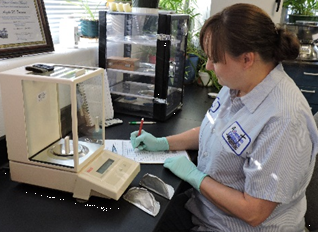 Angela Freeman, Chemist, completes testing daily to keep us in compliance with the EPA & ADEQ
Angela Freeman, Chemist, completes testing daily to keep us in compliance with the EPA & ADEQ
Homes--human and household wastes from toilets, sinks, baths, dishwashers, garbage grinders, clothes washers and drains.
Industry, Schools, and Business--chemical and other wastes from factories, food-service operations, school activities, hospitals, shopping centers, etc.
On the average, each person in the U.S. contributes 100 gallons of wastewater every day. If you include industrial and commercial water uses, the per person usage of water is as high as 150 gallons per day.
Wastewater treatment basically takes place in three stages:
Primary treatment, which removes 40-60% of the solids.
Secondary treatment, which removes about 90% of the pollutants and completes the process for the liquid portion of the separated wastewater.
Sludge (bio-solids) treatment and disposal.
Preliminary Wastewater Issues
STEP 1 - Sanitary sewers carry wastewater from homes and businesses to the raw wastewater pumping station at the treatment plant. The wastewater flows by gravity most of the time in the sanitary sewer pipes. Routine cleaning and closed circuit television inspection of Benton's sanitary sewer lines helps keep the sewer collection system in good shape.
STEP 2 - Fine Screens let water pass, but not trash (such as rags, diapers, etc.). There are four screens located at the plant. The trash from these screens is collected and properly compacted by two of the newer bar screens and disposed of at the landfill. The screened wastewater is pumped to the two aeration basins.
Primary Treatment
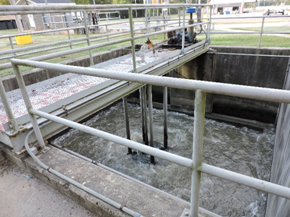
STEP 1 - The Aeration Basin supplies adequate amounts of air to the mixture of primary wastewater with the help of natural occurring bacteria and the other microorganisms that consume the organic matter. The growth of the helpful bacteria and microorganisms is speeded up by vigorously mixing air (aeration) with the concentrated microorganisms in the activated sludge and the wastewater. Adequate oxygen is supplied to support the biological process at a very active level. The ratio of food to micro-organisms is continually monitored and adjusted to meet daily variations in the wastewater.
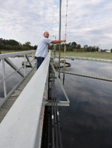
STEP 2 - Four Secondary Clarifiers allow the bio-solids of biological mass (the microorganisms) to settle from the water by gravity. 90-95% of this mixture, called "activated sludge," is returned to the aeration basins to help maintain the needed amount of microorganisms. The remaining 5-10 % is pumped to the aerobic digester.
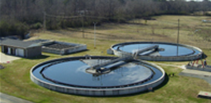
STEP 3 - Three Decanters provide the final step for the bio-solids before removal from the system. They are very slow turning clarifiers. These bio-solids are then removed from the system either by pumping them through a filtered belt press or by liquid removal hauling them to a permitted disposal site.
Filtered Belt Press - the bio-solids removed from the filtered belt press are then transferred to the dryer which then makes these bio-solids usable by turning them into a class A bio-solid which can be used anywhere according to EPA Regulations.
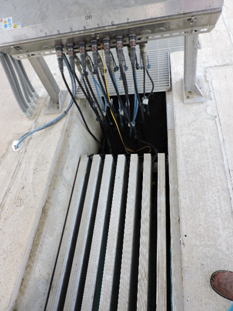
STEP 4 - The final effluent (liquid portion from Step 2) travels through the Trojan Ultra Violet Disinfection, and it is a physical process that instantaneously neutralizes microorganisms as they pass by ultraviolet lamps submerged in the effluent. The process adds nothing to the water but UV light, and therefore, has no impact on the chemical composition or the dissolved oxygen content of the water. In that respect, it ensures compliance with ever-tightening wastewater effluent discharge regulations.
All effluent returned to natural bodies of water must meet National Pollutant Discharge Elimination System (NPDES) criteria. The final effluent is monitored daily. In-house laboratory staff perform sampling and analysis for process control and NPDES compliance.
The bio-solids are utilized in an environmentally acceptable manner as a beneficial soil conditioner. The bio-solids applied to all sites are monitored for nutrients, metals, other compounds and pathogens.
The permitted liquid application sites are tested by an independent laboratory to assure that nothing harmful is being placed into the soil annually. Soil testing is performed at all sites prior to bio-solids application. The bio-solids that are being placed on the permitted fields are tested four times per year.
The final effluent is now being treated by the use of Ultra Violet lighting to neutralize the bacteria and pathogens where they can no longer reproduce. This facility no longer uses chlorine, which is a harmful chemical, to disinfect our discharged water from this facility.
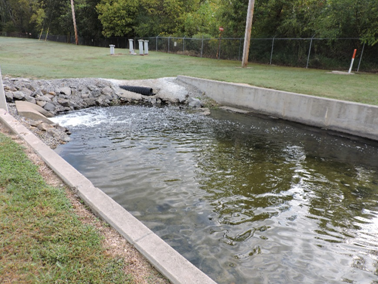
Specialty Equipment Utilized by this Department

Tanker Truck – This truck is primarily utilized to haul the bio-solids by our dept. However, it is also used to pump out lift stations when a pump fails, to help a pump station if is having trouble keeping up with the flow, to pump pits in the plant that aren’t attached to a pump, and to pump out and clean electrical manholes when the sump pump fails.
6” Trash Pump – This is a pump that will be utilized as a backup pump at liftstations and line breaks for both the wastewater collections dept. and the treatment plant. It will pump both solids and liquids at capacity.
Equalization Basin
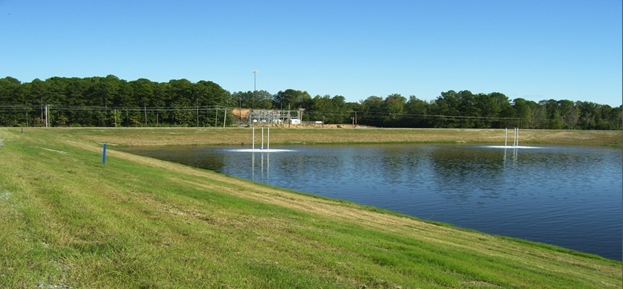
The 57 million gallon Equalization Basin is adequate to contain the diverted flow from the Wastewater Treatment Plant. This basin should have storage capability to contain approximately eight days worth of inflow. This would also allow us to manage the waste water plants daily flow which will give this facility better treatment control. The Equalization Basin has a generator for back up power should it lose commercial power.
Benton Utilities was mandated by the Arkansas Department of Environmental Quality (ADEQ) in April of 2005 by a Consent Order (CAO LIS No 05-158) mandating the City build an equalization basin due to high inflow and infiltration at the Wastewater Treatment Plant. The basin is sized to control the peak flows that occur during wet periods of the year. These flows can increase as much as three times the design flow of the Wastewater Treatment Plant which is currently 8.3 million gallons per day. This basin was completed a year early and was put in service in October 2007. In cooperation with the Wastewater Collections dept., we have worked to reduce the amount of Inflow and infiltration into our system by continuing an aggressive pipe bursting program which replaces bad sewer pipe with new and upsized piping.
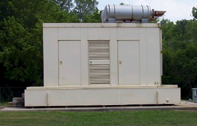
Back-up Generators – The treatment plant has four generators used to maintain operational controls of the facilities equipment in the event of the loss of commercial utility power.
In the event of such an outage these generators automatically convert to from commercial to generator power.
Work Completed . . . 36” Trunk Line – In order to improve flows on the northern side of Benton, Benton Utilities is currently using a trunk line that carries wastewater from the Thomas Pasture Lift station to the treatment plant. The recently installed Salt Creek Drainage Basin Lines flow to that lift station, and this trunk line also carries the waste from that lift station to the plant.
Treatment Plant Expansion – Benton Utilities is now using the new 5 million gallon extended aeration treatment plant expansion. This plant is adjacent to the existing extended aeration plant and will increase our capacity to 8.3 million gallons per day. This project included a new laboratory and an operator control building with a Supervisory Control and Data Acquisition System (SCADA System) to monitor flows and operations remotely. The Wastewater Treatment Plant and the Equalization Basin are monitored by cameras 24/7 to protect both areas.
Our goal is to provide the citizens of Benton with proficient treatment of their wastewater stream.